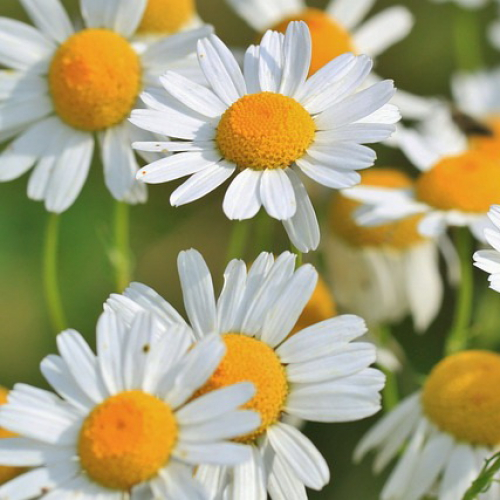Perennials Camomile

Description
Characteristic Features of Camomile
Camomile or Matricaria is a genus of annual and perennial herbaceous plants in the family Asteraceae or Compositae. In the wild, these graceful plants can be found in the forests, meadows, and fields. They have quickly gained popularity as ornamental garden plants and are now cultivated all over the world. It is the type of plant that everyone knows from a very early age.
The Latin name of the plant derives from "matrix" ("uterus"), which reflects the fact that Camomile has been widely used in the treatment of female diseases since ancient times. Roman writer and scholar Pliny the Elder called Camomile "Chamaemellon" ("earth apple" in Greek) because of its apple-like smell. The Russian name of the plant "Romashka" is a diminutive form of the "roman" and is a likely borrowing from Polish. In the 16th century, the Poles called this lovely plant the "Roman plant" from the Latin "Romana". Camomile has become so popular that any flowers with white petals and dark central disk are now commonly referred to as Camomiles.
Camomile has alternate, simple, or pinnatisect leaves. The stalk is erect, 15 to 100 centimetres tall. The flowers are collected in corymbose inflorescences, with white ray florets and yellow centres. Flowers are borne from the spring to late autumn. The fruit is a small three- or four-ribbed achene.
The genus Matricaria is represented by about 20 species, the most popular of which are the following:
German Camomile or Wild Camomile (Matricaria chamomilla or Matricaria recutita) is an annual widespread in Eurasia and North America, with a light brown taproot , an erect stem 15-55 centimetres tall, alternate ovate leaves, a hollow receptacle, and numerous inflorescences up to 2 centimetres across. This species has long been used in medicine and cosmetology. With its flowers containing glycosides, flavonoids, essential oil, azulene, anthemic acid, and ascorbic acid, Camomile is the most popular medicinal herb. Infusions of dried flowers help for a variety of medical conditions. German Camomile, in contrast to other species of this genus, has a characteristic apple-like scent.
Pineappleweed, Wild Camomile, or Disc Mayweed (Matricaria discoidea) is also used in medicine. It does not have white ray florets, which distinguishes it from German Camomile.
Feverfew (Matricaria eximia) is a perennial grown as an annual, up to 55 centimetres tall, with corymbose inflorescences.
Turfing Daisy (Matricaria tchihatchewii) is a low-growing plant with a leafless stem and a single terminal flower.
Shasta Daisy (Laucanthenum) is cultivated as an ornamental garden plant. This is a perennial with large enough flower baskets (up to 15 centimetres across) and an erect stem sometimes reaching a height of one metre. Besides varieties with conventional white ray florets, there are also cultivars with pink, yellow, red, burgundy, and purple ray florets. In addition, one can find unusual varieties with double flowers that resemble the chrysanthemum.
Leucanthemum kurilense is a perennial with dissected leaves, a low stem (20 centimetres) and large white flowers. It occurs mostly on islands and in rocky areas.
In landscaping, ornamental species of Camomile are used in flower borders, ridges, rockeries, mixed borders, flower beds, and along the paths. The best companion plants are cornflowers, bluebells, poppies, and grasses. Low-growing Camomiles are frequently grown in containers and make good cutting flowers with a long vase life.
The Secrets to Successfully Growing Camomile
In general, Camomile is not fussy about the type of the soils but it will do best in sunny locations with neutral sandy soil and good drainage.
The basic care for Camomile is very simple and includes regular weeding, loosening the soil, and watering. If you do not want to make a Camomile lawn, immediately remove spent flowers, as the plant is a profuse self-sower. Camomile responds well to compound fertilizers applied 2-3 times per season. For the winter, cut the aboveground part of the plant. In very cold winters, garden Camomile needs to be covered with non-woven fabric or dry leaves. Remove the sheltering immediately after the snow melts to prevent damping-off. Rejuvenate the plant every 4-5 years.
Camomile is propagated by seed. The seeds germinate well and are dispersed with wind and rain, which turns this highly ornamental plant into a weed that occupies the entire garden. Sow the seeds out in late summer, before winter, or in the spring. Do not sow deep and remember to water regularly. Seedlings appear within a week or two, and 4 months later, the plant is totally mature. The best temperature for germination is 20 ° C; in cool weather, you may cover the seedlings with PE film for better growth. Young plants should be thinned out.
You can sow the seeds indoors in March. Prick out seedlings once they have their first set of true leaves and plant into individual pots. Transplant in May to a permanent location spacing 30 centimetres apart.
Shasta Daisy is often propagated vegetatively. Carefully divide the shrub in August, preferably in cloudy weather and plant in the prepared holes or furrows.
Potential Problems
With poor care, the plant is prone to blight, rust, spot, grey mold, and powdery mildew. To prevent diseases, avoid waterlogging, weed regularly, and spray with fungicides. Cut off badly damaged plants at the root.
Sometimes Camomile can be affected by wireworms that feed on the roots, beet aphids, larvae of Trupanea stellatа that feed on flowers, spittlebugs, and thrips. Control pests with appropriate insecticides.







 7 750
7 750






